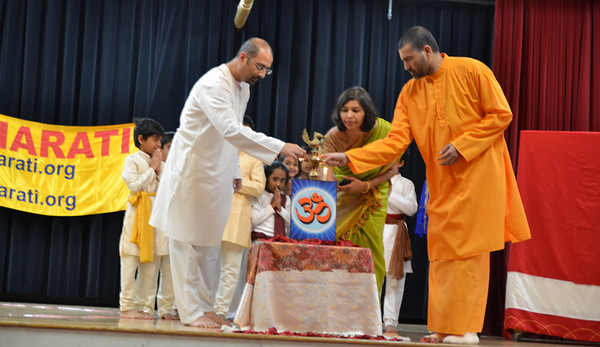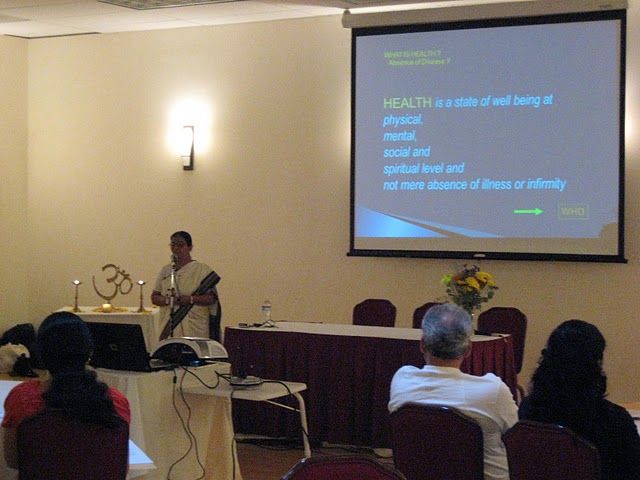Yoga Bharati brings a wealth of knowledge about yoga and its philosophy through Yoga Teacher’s training and its Diploma courses. The courses are brought from Vivekananda Yoga Research Foundation (SVYASA), Bangalore, India. We are now an affiliate center of the Hindu University of America in bringing Diploma in Yoga Wellness to our yoga teachers, a course that focuses on Therapeutic Applications of Yoga.
We are excited about the new yoga wave that Yoga Bharati is creating by bringing holistic yoga with its grand heritage and its depth of philosophy into the western world. With your help and support Yoga Bharati will further increase its pace of progress.
Presently Yoga Bharati has chapters in the following locations:
USA:
- SF Bay Area
- Detroit
- Los Angeles
- San Diego
Outside USA:
- Istanbul, Turkey
- Bengaluru, India
- Canada:
- Calgary
- Edmonton
- Vancouver
Accomplishments
We are proud of the great leap that Yoga Bharati has taken in its mission since its inception in 2002. In its efforts to spread its wings far and wide, Yoga Bharati has taken up various tasks and progressed in many areas. Below is an attempt to highlight some of the achievements.
Yoga Alliance (YA) Registration:
We are now a Registered Yoga School (RYS 200) with Yoga Alliance for our Yoga Instructors Course (YICC), a 200 hour course, enabling the teachers to become Registered Yoga Teacher (RYT 200). We also have plans to register for RYS 500. This is great news for the whole organization, as it will put us on the national map of yoga training in USA & elsewhere.
Yoga Classes:
Public yoga classes have taken a big leap. We have a total of six locations in the Bay Area where free classes are conducted, thanks to all our volunteers. In Sunnyvale alone, we are conducting 15 free classes per week. So a total of 20 classes, with a value worth $4000 given out to the community per week by Yoga Bharati Bay Area chapter alone!
In Los Angeles, free yoga classes are conducted in four different locations.
In Detroit chapter, apart from free yoga classes, yoga is also given to Multiple Sclerosis patients on a biweekly basis. Free yoga classes are conducted in San Diego chapter on weekends.
Yoga Teachers Training (YICC) 2010
As with every year, Yoga Bharati conducted YICC 2010, its flagship course. In Bay Area, we conducted this course for three months from April to June months. Anil Surpur, Venkat Reddy and Shailesh Basani were the coordinators of this course. As with every year, our Chairman and spiritual founder, Shri. N.V.Raghuram was the faculty for Yoga Philosophy Course(YPC) that is a part of YICC. Twenty-five students took this course and it was very well received, especially Raghuramji lectures.
In Detroit, YICC was conducted in April and Raghuramji conducted the theory sessions (YPC). YICC will be conducted Bay area Chapter, LA chapter and Detroit chapters in 2011.
Partnership and Collaboration:
Yoga Bharati works with other organizations to help build network, spread the awareness and as a reach out program. We collaborate with Sambodh Society for conducting annual workshops on Meditation, Yoga Philosophy and Vedanta. We provide free classes at Chinmaya Mission Balavihar programs, at India Community Center (Milpitas, Bay Area) and other locations. The children of Yoga Bharati’s “Yoga and Gita for Kids” class participated in Chinmaya Mission Gita Competition and bagged awards! We also work with Samskrita Bharati in providing yoga for their Sanskrit Workshops and with Ekal Vidyalaya, training Ekal Marathon volunteers and conducting yoga class for Marathoners.
Yoga Therapy sessions Bay Area:
Yoga Bharati Bay Area chapter has made a great leap in therapeutic applications of yoga. Yoga classes have been continuously running for the last two years with significant results. What started as a simple yoga activity in Anil and Ashwini Surpur’s garage (Yoga Bharati headquarters) has now turned into a bigger program and we have moved to a new rented facility. We conduct yoga for kids, yoga for back/neck/shoulder pain, arthritis, hypertension, diabetes, weight loss and stress management, to name a few. Ashwini Surpur is heading the Yoga Therapy division and is conducting this program with the help and advice of Dr. Nagarathna, the Chief Therapist at SVYASA Arogyadhama. The goal of Yoga Bharati’s yoga classes for ailments is three-fold:
- Help people with their ailments
- Spread the awareness about therapeutic benefits of yoga
- Develop research on how yoga can help in achieving positive health for individual and society
Detroit (MS Society)
Since 2006, Yoga Bharati certified instructor, Ms. Sudha Rao has been devoting two hours on a bi weekly basis to teach yoga to people with Multiple Sclerosis at the MS society in Southfield, Michigan. The MS patients have noticed a significant improvement in their flexibility and movements. Ms. Rao intends to conduct a research study on the benefits of Yoga in MS patients in the near future. She is joined in this effort by Dr Deepa Parikh has been working with the group since the summer of 2010 on a biweekly basis.
Advanced Diploma in Yoga Wellness
(RYT 500 Advanced Yoga Teachers Training) Inaugurated by the Vice Chancellor of SVYASA and President of HUA, Dr. H.R.Nagendra, the Bay Area chapter launched Diploma in Yoga Wellness, a course for higher studies in yoga and its therapeutic applications. This course is brought in collaboration with HUA and SVYASA. Six students have registered for the first batch and classes are regularly conducted in Yoga Bharati HQ. The classes started with Dr. Nagarathna giving us an in-depth course on Yoga for Ailments – a three day intensive workshop in Sept 2010.
Apart from the diploma course, we are also conducting certification courses for teachers who can conduct classes for specific ailments such as back pain, diabetes, etc. We have three students registered for this course. The diploma course will be registered with Yoga Alliance as RYT 500 level course.
The yoga classes for ailments help us in providing a training ground and opportunity for case studies for our diploma students. Some of our diploma students are going to SVYASA’s Arogyadhama (Prashanti – health center of SVYASA at Bangalore) for the first round of clinical observation. Ashwini Surpur, Director of Yoga Therapy, is conducting the Diploma course, both as a faculty and as a coordinator. We have a faculty of doctors who teach Anatomy classes for our diploma students. Sri N.V.Raghuram and Swami Bodhananada Saraswati are our faculty for Philosophy and Vedanta. We have also lined up a host of experts in various yoga and Alternative Therapy fields locally, to give our students a quality education and in-depth knowledge in yoga.
Yogathon 2010
On August 29, 2010, Yoga Bharati chapters all over the US joined hands with the Hindu American Seva Charities to participate in Yogathon 2010 at US level. This was a faith based initiative by Obama government. A free yoga workshop for youth and adults with an introduction to the traditional concepts of yoga was conducted in various locations such as temples, community halls, etc. This effort was spearheaded by Anil Surpur in Bay Area Chapter and Mahaveer Khetawat in Detroit Chapter, Shankar.N at San Diego Chapter and Sharad Dandekar at Los Angeles Chapter
Satsangs and Workshops:
Doctors Workshop 2010
Yoga Bharati Bay area chapter organized a workshop for doctors and medical practitioners at India Community Center (ICC) Milpitas on Sunday, Sep 19th, 2010. The workshop was well attended by a group of over twenty-five healthcare professionals. There were specialists in all fields of medicine such as cardiology, oncology, obstetrics, internal medicine and therapists. The workshop was arranged to generate awareness on yoga therapy and its benefits on the patients. Dr. Nagarathna, the Dean of Health Sciences and Chief Therapist of SVYASA chaired the panel. Other panelists were our Chairman N.V.Raghuram, Dr. Naras Bhat the Cardiologist and faculty at UC Berkeley, Dr. Raji Ayyar, the oncologist at Kaiser and Smt. Pratichi Mathur, Ayurvedic practitioner and founder of Vedika Global. The program was extremely well received and the doctors got to understand the research that SVYASA has conducted in yoga and its benefits in addressing various ailments including cancer.
Yoga Philosophy by Shri N.V.Raghuram
This year, Sri N.V.Raghuram taught the theory part of Yoga Teacher’s Training in Bay Area and Detroit chapters. He also conducted workshops on Pranayama, SMET and gave discourses on Bhagavad Gita and other topics in Bay Area, Detroit, Los Angeles area and Canada. The sessions were packed with 60-90 people with Canada program topping the list where more than 200 people attended the program and the feedback was marvelous.
Prof. Sastry Memorial 2010
Once a year, Yoga Bharati Detroit chapter celebrates the life and teachings of Prof. Satyanarayana Sastry in the form of a day- long spiritual workshop. Prof. Sastry was the mentor of our own beloved guru, Raghuramji. This year’s topic was the Concept of Fullness. Raghuramji discussed the concepts established in Ishavasya Upanishad.
SMET and PET workshops by Dr.Nagendra
Dr. Nagendra (Guruji), the Vice-Chancellor of Swami Vivekananda Yoga Research Foundation (SVYASA) visited Bay Area twice in 2010, each time giving us various programs in different locations of Bay Area. His programs were very well received with more than 100 people attending his event in April at a very short notice. Guruji gave us insight into how yoga helps in addressing different ailments, with SVYASA’s comprehensive research data.
Workshop by Swami Bodhananda Saraswati
Bay Area chapter conducted annual meditation programs by Swami Bodhananda Saraswati of Sambodh Society. This year, he conducted workshops on Meditation I (Beginners) and II (Advanced), and weekend courses on Patanjali Yoga Sutra and Brahmasutra Bhashya of Shankaracharya. The program were well received and well attended.
Study Groups:
In an attempt towards our own Self Growth and our progress in spirituality, Yoga Bharati conducts study groups in its various chapters for its yoga teachers and volunteers. In Bay Area, regular monthly study groups are conducted where discussions on Bhagavad Gita shlokas, asanas and pranayama techniques, meditation practices, etc are carried out. Detroit Chapter conducts monthly study groups on Bhagavad Gita and Patanjali Yoga Sutras.
Plans for 2011
Apart from further progress in the above programs, we will be planning the following:
Surya Namaskar Yagna (Sun Salutations Marathon)
Yoga Bharati is planning to do a research on the benefits of Surya Namaskar (SNY) on yoga participants. We will be collecting baseline health parameter data such as their blood pressure, BMI, weight, pulse rate, etc., from the participants and we will be tracking the progress that they make through the practice of Surya Namaskars and some simple asanas and pranayama. Participants can get baseline reading from the supporting medical practitioners before and after the entire Sun Salutations marathon for 6 weeks. We will compile this data & present it as research data to show the benefits of SNY practice.
Yoga Teachers Training 2011
Yoga Bharati Bay area and LA chapters will be conducting Yoga teachers Training (YICC) during April – June months.







